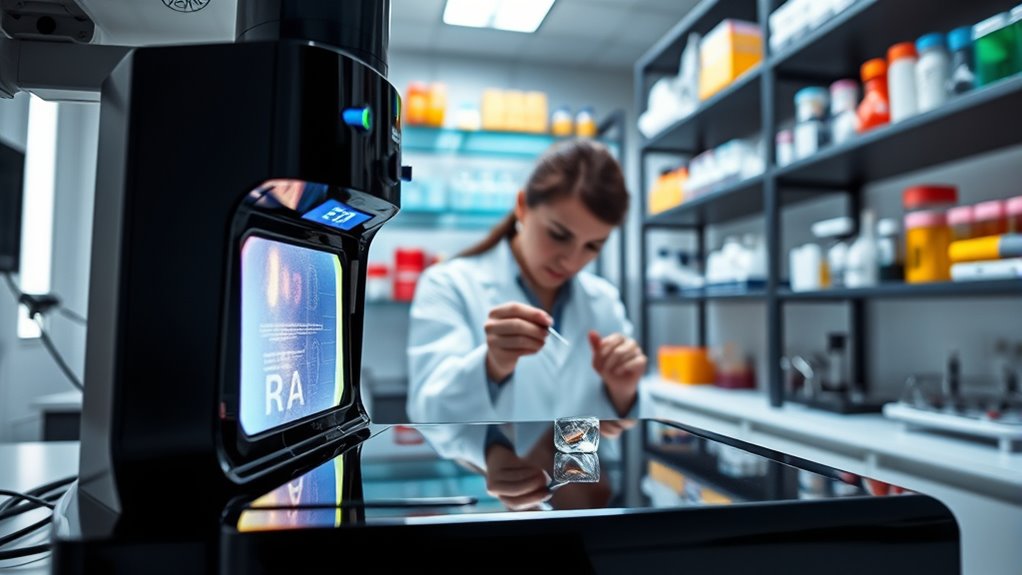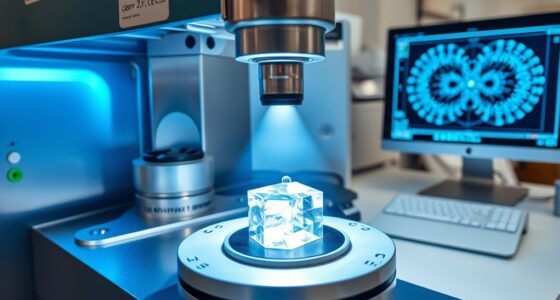FTIR spectroscopy is a powerful tool that helps you identify materials across many fields, from art forensics to explosives detection. You analyze molecular vibrations to pinpoint the chemical makeup of samples, which makes the process quick and non-destructive. Proper sample preparation guarantees accurate results, whether working with solids, liquids, or gases. By understanding spectral fingerprints, you can accurately recognize substances and solve complex problems, and if you explore further, you’ll discover even more fascinating applications.
Key Takeaways
- FTIR provides rapid, non-destructive chemical analysis essential for identifying materials in both art forensics and explosive detection.
- Proper sample preparation (e.g., grinding solids, placing liquids on salt plates) enhances spectral quality and accuracy.
- Unique spectral fingerprints enable precise identification of complex substances across diverse fields.
- Spectral interpretation involves comparing observed spectra with reference databases to determine sample composition.
- FTIR’s versatility allows its application from analyzing artwork materials to detecting hazardous explosive residues.

Have you ever wondered how scientists identify the chemical composition of a substance quickly and accurately? When using Fourier-transform infrared (FTIR) spectroscopy, the process begins with sample preparation. This step is vital because it guarantees that the sample is suitable for analysis. Depending on the material—solid, liquid, or gas—you’ll need to prepare it differently.
For solids, you might grind the sample into a fine powder and press it into a pellet with potassium bromide (KBr). Liquids can often be placed directly onto a salt plate, while gases require specialized cells. Proper sample preparation minimizes interference and improves the quality of the spectral data, making interpretation straightforward. Additionally, understanding the spectral fingerprint is essential for accurate identification. The choice of sample preparation method can also influence the spectral resolution and sensitivity of the analysis.
Once your sample is ready, you expose it to infrared light, which interacts with the molecules, causing them to vibrate at characteristic frequencies.
Exposing samples to infrared light induces molecular vibrations at specific frequencies, revealing their chemical fingerprint.
Spectral interpretation is where the real magic happens. As infrared light passes through or reflects off your sample, specific wavelengths are absorbed based on the chemical bonds present. The FTIR instrument captures this information and converts it into a spectrum—a graph displaying absorbance versus wavenumber.
This spectrum acts like a molecular fingerprint, revealing the unique vibrational modes of the sample’s chemical bonds. To identify what’s in your sample, you compare its spectrum with reference spectra stored in databases or literature. Recognizing the peaks and their corresponding functional groups allows you to determine the composition swiftly.
This process requires a keen eye and understanding of molecular vibrations, but with practice, spectral interpretation becomes an intuitive task. Often, software tools assist by matching your spectrum to known profiles, speeding up the identification process.
In forensic science, this technique helps analyze trace evidence, such as fibers or paint chips, to link suspects to crime scenes. In environmental studies, FTIR detects pollutants in water or soil samples.
When it comes to explosives detection, the method offers a non-destructive way to identify hazardous substances rapidly, even at low concentrations. The speed and precision of FTIR make it invaluable across various fields, especially when time is critical.
Its ability to deliver instant, reliable data hinges on meticulous sample preparation and sharp spectral interpretation. By understanding these foundational steps, you can harness FTIR spectroscopy to reveal the chemical secrets of substances with confidence, making it a powerful tool in both forensic investigations and safety protocols.
Frequently Asked Questions
How Does FTIR Distinguish Between Similar Chemical Compounds?
You can distinguish between similar chemical compounds using FTIR by analyzing their spectral fingerprints. This technique captures unique patterns based on molecular vibration analysis, revealing subtle differences in how molecules absorb infrared light.
What Are the Limitations of Infrared Spectroscopy in Complex Mixtures?
You might think infrared spectroscopy can effortlessly unravel complex mixtures, but spectral overlap often fools you, blending signals and muddying results. Quantitative challenges arise because overlapping peaks make it tough to precisely measure individual components. So, despite its elegance, IR spectroscopy hits a wall with intricate samples, forcing you to rely on advanced techniques or complementary methods for accurate analysis—proof that simplicity isn’t always guaranteed in chemistry.
Can FTIR Be Used for Real-Time, On-Site Analysis?
You can use portable FTIR devices for real-time, on-site analysis, making it a practical tool in various fields. These devices offer quick results, allowing you to identify materials immediately.
Data integration from portable FTIR systems streamlines decision-making, enabling you to analyze complex samples efficiently.
While some limitations exist, advancements continue to improve their accuracy and usability, making on-site, real-time analysis more accessible and reliable for your needs.
How Does Sample Preparation Vary Across Different Applications?
When considering how sample preparation varies, you’ll find that sample handling and preparation protocols depend on the application.
For art forensics, you might need minimal handling to avoid damage, while explosives detection requires careful extraction and contamination prevention.
You adapt your protocols to guarantee accurate readings, whether by grinding, diluting, or applying specific coatings.
Tailoring preparation protocols ensures reliable results across different fields and sample types.
What Advancements Are Expected in Infrared Spectroscopy Technology?
You can expect advancements in infrared spectroscopy like miniaturization, making devices more portable for on-the-go analysis. Spectral resolution will improve, allowing you to distinguish between closely related compounds with greater accuracy. These innovations will enable quicker, more precise detection across fields such as environmental monitoring and security, transforming how you perform analytical tasks.
As technology evolves, you’ll find infrared spectroscopy more accessible, versatile, and powerful for various scientific and practical applications.
Conclusion
You’ve seen how Fourier‑transform infrared spectroscopy transforms tiny molecular whispers into vivid stories, bridging art forensics and explosives detection. This technique’s power is like a flashlight in a pitch-black room, revealing secrets hidden in plain sight. As you explore its potential, remember it’s revolutionizing fields faster than you can blink, turning complex chemical puzzles into clear, actionable insights. Embrace this marvel—because in the world of science, it’s truly a game-changer.









